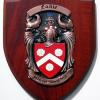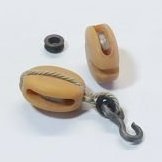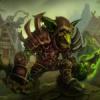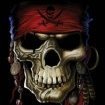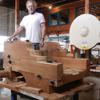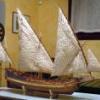-
Posts
1,267 -
Joined
-
Last visited
Reputation Activity
-
 AnobiumPunctatum reacted to dvm27 in Speedwell 1752 by dvm27 (Greg Herbert) - FINISHED - Ketch Rigged Sloop
AnobiumPunctatum reacted to dvm27 in Speedwell 1752 by dvm27 (Greg Herbert) - FINISHED - Ketch Rigged Sloop
Been awhile since my last Speedwell update. Work on the forecastle has finished, for the most part. Caulking is black paper. It's a bit more work but a little cleaner than when I use a pencil. The wrought iron belfry is unusual but present on the contemporary model. I twisted 1/32" square brass bar stock with one end in a stationary vice and the other end in a pin vice. Consistent upward pressure while twisting insures an even result.
-
 AnobiumPunctatum reacted to RGL in VARYAG by RGL -FINISHED - Artwox - 1/350 - Plastic, resin and photoetch - Protected Cruiser
AnobiumPunctatum reacted to RGL in VARYAG by RGL -FINISHED - Artwox - 1/350 - Plastic, resin and photoetch - Protected Cruiser
Second last post, just a scale comparison. 1/60 Vs 1/350.
-
 AnobiumPunctatum reacted to Chuck in HM Cutter Cheerful 1806 by Chuck - FINISHED - 1:48 scale - kit prototype
AnobiumPunctatum reacted to Chuck in HM Cutter Cheerful 1806 by Chuck - FINISHED - 1:48 scale - kit prototype
Thank You very much . Just a small update as I got tired of making rope today. I started in the chainplates and deadeyes. They are made pretty much like the others I showed, only longer. The deadeyes are stroped with 22 gauge black wire. I have six more to go and probably will get that done after Thanksgiving. I wish all of you a happy and tummy stuffing turkey day.
Chuck
-
 AnobiumPunctatum got a reaction from Bobstrake in HM Cutter Cheerful 1806 by Chuck - FINISHED - 1:48 scale - kit prototype
AnobiumPunctatum got a reaction from Bobstrake in HM Cutter Cheerful 1806 by Chuck - FINISHED - 1:48 scale - kit prototype
I can only second Marcs words. Your logs are really helpful
-
 AnobiumPunctatum reacted to Siggi52 in HMS Dragon 1760 by Siggi52 - FINISHED - Scale 1:48 - English 74-Gun ship
AnobiumPunctatum reacted to Siggi52 in HMS Dragon 1760 by Siggi52 - FINISHED - Scale 1:48 - English 74-Gun ship
Hello,
the furniture for the great cabin is now ready. First a desk and a sofa.
And here is all finished and painted.
The next days I will make some smaller things, like books, glasses and bottles. I would't make lanterns for these cabins, because I think that the servants of the captain will bring them in when it is necessary.
Regards,
Siggi
-
 AnobiumPunctatum reacted to Siggi52 in HMS Dragon 1760 by Siggi52 - FINISHED - Scale 1:48 - English 74-Gun ship
AnobiumPunctatum reacted to Siggi52 in HMS Dragon 1760 by Siggi52 - FINISHED - Scale 1:48 - English 74-Gun ship
Hello,
so, the last pictures of the quarter deck without deck beams.
I build some books, bottles and glasses. May be the captain is discussing with a guest something and spend a glas of Port or Madera during that.
The next thing would be the poop deck. Here I have a question. When I get Brian Lavery right, then the ships before 1800 did't have iron hopes around the masts. Only woldings and only on made masts. Was the mizzen mast a made mast? I read there different things. Lavery drew woldings above the poop deck, but iron hopes also below that.
Should I build woldings and when, where?
Next question. Should I build also partners of the mast at the poop deck. At the contemporary models you see often nothing or just a turned ring, like this from the Bellona.
Goodwin wrote that it was a more common practice, that the partners where higher then the deck beams, but also higher then the deck, what you could see at the Victory. At the quarter deck I build it so. So what is right?
And when I see the last picture, a last question. Did't they have belaying pins in the cross beams? I know no model that have them. Or is that only a short cut?
Regards,
Siggi
-
 AnobiumPunctatum reacted to dvm27 in THE 74-GUN SHIP by Jeronimo
AnobiumPunctatum reacted to dvm27 in THE 74-GUN SHIP by Jeronimo
Beautiful symmetry and geometry Jeronimo!
After several plank on frame models I really believe that cutting in the sills after all the frames are raised insures the sweetest line of ports. In that respect builders of French models are lucky in that the sills are much easier to execute than the angled mortises on British vessels.
-
 AnobiumPunctatum reacted to Jeronimo in THE 74-GUN SHIP by Jeronimo
AnobiumPunctatum reacted to Jeronimo in THE 74-GUN SHIP by Jeronimo
Hello friends,
many thanks to all for your kind comments and Likes.
Built gun ports and jamb walls.
Karl
T e i l 6
-
 AnobiumPunctatum got a reaction from Jack12477 in HM Cutter Cheerful 1806 by Chuck - FINISHED - 1:48 scale - kit prototype
AnobiumPunctatum got a reaction from Jack12477 in HM Cutter Cheerful 1806 by Chuck - FINISHED - 1:48 scale - kit prototype
I can only second Marcs words. Your logs are really helpful
-
 AnobiumPunctatum got a reaction from mtaylor in HM Cutter Cheerful 1806 by Chuck - FINISHED - 1:48 scale - kit prototype
AnobiumPunctatum got a reaction from mtaylor in HM Cutter Cheerful 1806 by Chuck - FINISHED - 1:48 scale - kit prototype
I can only second Marcs words. Your logs are really helpful
-
 AnobiumPunctatum got a reaction from GLakie in HM Cutter Cheerful 1806 by Chuck - FINISHED - 1:48 scale - kit prototype
AnobiumPunctatum got a reaction from GLakie in HM Cutter Cheerful 1806 by Chuck - FINISHED - 1:48 scale - kit prototype
I can only second Marcs words. Your logs are really helpful
-
 AnobiumPunctatum got a reaction from Chuck in HM Cutter Cheerful 1806 by Chuck - FINISHED - 1:48 scale - kit prototype
AnobiumPunctatum got a reaction from Chuck in HM Cutter Cheerful 1806 by Chuck - FINISHED - 1:48 scale - kit prototype
I can only second Marcs words. Your logs are really helpful
-
 AnobiumPunctatum reacted to mtaylor in HM Cutter Cheerful 1806 by Chuck - FINISHED - 1:48 scale - kit prototype
AnobiumPunctatum reacted to mtaylor in HM Cutter Cheerful 1806 by Chuck - FINISHED - 1:48 scale - kit prototype
Chuck,
Your logs are one of those that set the standards for tutorials. Beautiful smithy work.
-
 AnobiumPunctatum got a reaction from Eddie in HM Sloop Fly by AnobiumPunctatum - 1:32 - POF
AnobiumPunctatum got a reaction from Eddie in HM Sloop Fly by AnobiumPunctatum - 1:32 - POF
Today I've finished the drawing work for the frames. 55 frames and 26 cant frames are a lot stuff, which I have to build now.
The following picture shows frame 10a for example.
Now I have to clean up my work room and prepare the building board. I hope I've nothing forgotten so that I can make sawdust and start the build of my model
-
 AnobiumPunctatum got a reaction from Captain Poison in HM Sloop Fly by AnobiumPunctatum - 1:32 - POF
AnobiumPunctatum got a reaction from Captain Poison in HM Sloop Fly by AnobiumPunctatum - 1:32 - POF
Today I've finished the drawing work for the frames. 55 frames and 26 cant frames are a lot stuff, which I have to build now.
The following picture shows frame 10a for example.
Now I have to clean up my work room and prepare the building board. I hope I've nothing forgotten so that I can make sawdust and start the build of my model
-
 AnobiumPunctatum got a reaction from ggrieco in HM Sloop Fly by AnobiumPunctatum - 1:32 - POF
AnobiumPunctatum got a reaction from ggrieco in HM Sloop Fly by AnobiumPunctatum - 1:32 - POF
Today I've finished the drawing work for the frames. 55 frames and 26 cant frames are a lot stuff, which I have to build now.
The following picture shows frame 10a for example.
Now I have to clean up my work room and prepare the building board. I hope I've nothing forgotten so that I can make sawdust and start the build of my model
-
 AnobiumPunctatum got a reaction from Fam in HM Sloop Fly by AnobiumPunctatum - 1:32 - POF
AnobiumPunctatum got a reaction from Fam in HM Sloop Fly by AnobiumPunctatum - 1:32 - POF
Today I've finished the drawing work for the frames. 55 frames and 26 cant frames are a lot stuff, which I have to build now.
The following picture shows frame 10a for example.
Now I have to clean up my work room and prepare the building board. I hope I've nothing forgotten so that I can make sawdust and start the build of my model
-
 AnobiumPunctatum reacted to Chuck in HM Cutter Cheerful 1806 by Chuck - FINISHED - 1:48 scale - kit prototype
AnobiumPunctatum reacted to Chuck in HM Cutter Cheerful 1806 by Chuck - FINISHED - 1:48 scale - kit prototype
The channels are in and I added the eyebolts to the exterior of the hull. I also drilled the scuppers which was pretty straight forward. Then I started to fabricate the plates for the backstays. These were made using 1/64" x 3/32" brass strips. The K&S strips are soft and can be filed easily to shape. You can see the progression of steps used to make them. There will be three chainplates on each side of the hull.
I started by drilling the hole at the bottom and rounding it off.
Then I used a round file to notch the strips on both sides as shown in step two. This will be the top of the chain plate where it gets thinner.
In step three I used a flat file to extend that thinner portion on top so I could bend it into a loop like making an eyebolt.
Step four is where I cut off the top excess strip and tapered the bottom portion so it got slightly narrower as it worked its way to the top.
The last two examples show the chainplate completed with the thin portion of the brass on top bent into a loop. This will get a hooked tackle when it comes time to rig the back stays. I used small little brass pins....you know the ones...they come in every kit and I have a whole bunch of them.
Next its on to the deadeyes and chainplates for the channels. Its really the same procedure to make those except we will add a stroped deadeye to the top of each.
The outboard details are almost all complete. Once the deadeyes are completed there is only the rudder and fixed block on the stem. Then we finish up inboard!!!!
-
 AnobiumPunctatum reacted to EdT in Young America 1853 by EdT - FINISHED - 1:96 - POB - extreme clipper
AnobiumPunctatum reacted to EdT in Young America 1853 by EdT - FINISHED - 1:96 - POB - extreme clipper
Young America 1853 – POB 1:96
Part 34 – Main Deck Finishing
After all the deck planking was installed, it had to be leveled off and finished. Regardless of how well the plywood bulkheads and the added under-deck supports are faired off beforehand, it will be necessary to level off the planking using a combination of filing with flat rifflers and/or sanding with coarse (say 120-grit) paper. If you are building the model, I hope you will pay more attention to the bulkhead fairing work than I did. My fairing could have been a bit more thorough. The deck has some waviness, but only those permitted to touch it will notice. Regardless of the perfection of the bulkhead fairing, it will be prudent to start with heavier deck planks – say 4 ½” thick vs. the final 3 ½”.
The first picture shows some 220-grit finish sanding being done after all the irregularities between planks were leveled out using a flat riffler.
I used this model to experiment with deck finish. On the larger model, beeswax thinned with turpentine was used on all unpainted wood – after more extensive sanding and polishing. After sanding with 220-grit, I finished this decking with water based, acrylic sanding sealer thinned to about 50% with water – two coats, each sanded smooth – 220-grit then 320-grit. The planking was then coated with acrylic gloss artists’ varnish. Two coats, thinned, each sanded with 320-grit and then rubbed with Scotchbrite® grey then white grades. This left a silky satin finish on the deck. Simulated deck fastenings were embossed after the first coat of varnish. I used a piece of syringe tubing for this and felt that the varnished surface would better resist pulling out small plugs.
Deck fastenings on these ships were normally iron spikes driven into counter-bored holes that were later filled with wood plugs that usually matched the decking. The next picture shows the embossing in progress.
For this work a length of syringe was held in a pin vise that could then be lightly tapped with a hammer. I was very careful to emboss all fastenings directly over bulkheads or other under-deck supports to avoid the possibility of breaking the planks. I used a light pencil line across the deck for each row, then alternated fastenings on either side of the line.
The next picture shows the tools used for this.
The syringe tubing had an OD of about 1 ½” and a sharp bevel was stoned around its end. I used a scriber point to flare out the end slightly to avoid plugs being jammed in and pulled out. The second pin vise shown was fitted with a small drill to use for cleaning out the end of the syringe as it became fouled.
After this embossing work, the deck was sanded with 320-grit paper and rubbed out with Scotchbrite® in preparation for the final varnish coat. This was then applied, left to dry, sanded with 320-grit, and finally rubbed out with grey then white grades of Scotchbrite®. This left a polished sheen on the deck as shown in the next picture.
I felt that the acrylic varnish worked out quite well. It dried hard enough to be rubbed out and polished to the sheen I was looking for. Below is a picture of some of the finishing materials and brushes used on the model.
The finish used on the decks was Liquitex® High Gloss Varnish applied with the flat synthetic brushes shown. High gloss finishes contain no flatting agents so they can be rubbed out to the desired sheen without being limited by the dulling agents used in semi-gloss or matte finishes. The Scotchbrite® pads mentioned above were used for this and are shown in the picture. The black Golden Fluid Acrylic® shown in the picture was used on the hull finish – to be described later.
Ed
-
 AnobiumPunctatum reacted to EdT in Young America 1853 by EdT - FINISHED - extreme clipper
AnobiumPunctatum reacted to EdT in Young America 1853 by EdT - FINISHED - extreme clipper
Young America - extreme clipper 1853
Part 125 – Helm
First, thank you, Bob. Gross exaggeration, of course, but much appreciated nonetheless.
The term helm refers to all the equipment and structures associated with the rudder. Unlike earlier ships where the wheel operated a tiller that turned the rudder by means of a system of ropes and sheaves, most ships of the clipper era used gear driven machinery to rotate the rudder. It is most likely that Young America used a mechanism consisting of reversed thread worm gears that drove a collar at the top of the rudder post. Gearing of this type had more mechanical advantage and resisted reverse forces generated by pressure on the rudder. Wheels could therefore be single and smaller even though the ships were larger and faster. Higher speeds put more stress on the rudder.
I did not intend to model the rudder machinery, given the scale and the fact that it is enclosed from view. (The small wheel was enough of a challenge for me.) However, the lower part of the heavy machine base that supported the gearing would be visible because the rudder enclosure is open at the bottom. The first picture shows the rudder shaft and a brass turning that models the lower part of the cast iron machine base.
In the next picture the rudder head has been shortened and the iron base blackened.
The base was simply glued to the deck using medium viscosity CA. The next picture shows the completed helm enclosure waiting for the wheel.
The enclosure is fixed temporarily to the deck on wire pins into the corner posts. This will allow the helm - with the fragile wheel - to be left off the model where it will be safe from damage as other work proceeds.
In the next picture the wheel axle has been fitted into a solid block inside the enclosure and two small grated platforms have been installed to help keep the helmsman’s feet dry.
The helm enclosure was made by the same methods used on the other deck structures so I will not describe that here. The last picture shows the completed helm with the wheel fitted.
I was fortunate to be able to use some grating left over from the 1:96 Victory model – just enough for the two raised platforms. I will cover making the wheel in the next part.
Ed
-
 AnobiumPunctatum reacted to rafine in Cutter Cheerful 1806 by rafine - FINISHED
AnobiumPunctatum reacted to rafine in Cutter Cheerful 1806 by rafine - FINISHED
I've taken the first step in the deck planking process. I made and installed the margin planks and waterway. I am doing the deck planking in holly, so the the margin planks were done with holly sheet and strip. The bow sections were cut from holly sheet, using card templates. The remaining sections were done by edge bending holly strip. The small pieces at the stern were shaped and beveled to fit. The waterway was made from 1/32" square strip that was rounded and painted red before installation.
I also painted black the areas under the gratings and skylight. Finally, before moving on to the deck planking itself, I drilled holes for the bulwark eyebolts and ringbolts. This was done now to avoid interference during drilling from the deck structures that will be installed prior to deck planking. The eyebolts were installed now. The ringbolts will be done at the time that the guns are installed and rigged.
Bob
-
 AnobiumPunctatum reacted to SawdustDave in Cutter Cheerful 1806 by SawdustDave - FINISHED - 1:48th scale
AnobiumPunctatum reacted to SawdustDave in Cutter Cheerful 1806 by SawdustDave - FINISHED - 1:48th scale
Rigging progress update....
No attempt to describe the rigging sequence here, as Chuck P will be doing a much better job in that area in his continued development of his Cheerful build log.
Following his plan sheets and calling on him for a few clarifications along the way, I have managed to arrive at this point of being approximately 80% rigged.
>
..
>
>
>
>
>
>
Next, I will rig the shrouds and begin the hateful task of tying rat lines.
Then, the yards.... already built.
Then, anchors, and flags, and name plate....
Then, display base.
Then I have to finish up the little decoy ship.
Much to do yet, but I think I will make it before my December 4th deadline.
-
 AnobiumPunctatum reacted to rekon54 in Le Fleuron 1729 by rekon54 - 1:24
AnobiumPunctatum reacted to rekon54 in Le Fleuron 1729 by rekon54 - 1:24
......
an affectionate greeting to all rekon54 -
 AnobiumPunctatum reacted to Dan Vadas in HMS Vulture 1776 by Dan Vadas - FINISHED - 1:48 scale - cross-section - from TFFM books
AnobiumPunctatum reacted to Dan Vadas in HMS Vulture 1776 by Dan Vadas - FINISHED - 1:48 scale - cross-section - from TFFM books
Thank you John, Ben, David and Greg.
All the frames have been assembled, now I can start fitting them to the keel.
I started by gluing the three Deadflat frames together, using spacers and Fillers of the appropriate thickness :
Then I set the assembly up on the board, using the acrylic square I built for Vulture's frames. A little bit of finessing on the slots for the keel was needed to get a good tight fit. The board and square, and also the two temporary supports, ensure that each frame goes up correctly :
Danny
-
 AnobiumPunctatum reacted to Remcohe in HMS Kingfisher 1770 by Remcohe - 1/48 - English 14-Gun Sloop - POF
AnobiumPunctatum reacted to Remcohe in HMS Kingfisher 1770 by Remcohe - 1/48 - English 14-Gun Sloop - POF
I made an error in the building sequence and I should have installed the main mastpartner earlier. Now I got a bit into trouble getting it in at this stage. I had to take a shortcut and omitted half lapping the carlings under the deck beam. After the gratings are installed this won't be visible, but I'm confessing this error anyway :-)
Getting the pump tubes right was a bit of trial and error but after not to much work they were in place without to much hassle, I guess I was lucky today. I added iron bands at the end of the tubes from thin paper.
Remco






